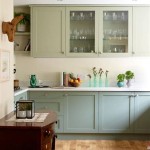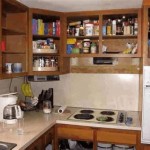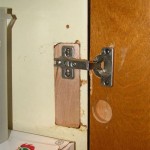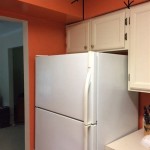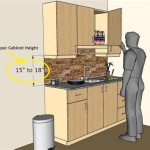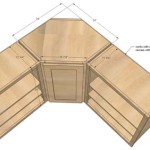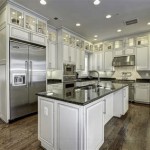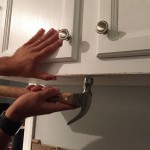```html
Illuminating Your Culinary Space: A Guide to Lighting Inside Kitchen Cabinets
Kitchens are increasingly recognized as more than just functional spaces for food preparation. They serve as gathering places, social hubs, and extensions of personal style. Efficient and aesthetically pleasing lighting plays a crucial role in enhancing the kitchen's usability and ambiance. While general and task lighting address overall illumination needs, incorporating lighting inside kitchen cabinets offers a unique opportunity to improve functionality and elevate the kitchen's design. This article explores the benefits, types, installation considerations, and aesthetic potential of lighting inside kitchen cabinets.
The practice of integrating light within cabinets is not merely a decorative flourish. It addresses several practical challenges inherent in kitchen design. Overhead lighting often casts shadows within cabinets, making it difficult to locate specific items. This issue is particularly prevalent in deeper cabinets or those positioned under overhanging countertops. Internal cabinet lighting effectively eliminates these shadows, providing clear visibility of contents and minimizing the frustration associated with searching for ingredients or utensils.
Furthermore, cabinet lighting can contribute to overall kitchen safety. When navigating a dimly lit kitchen, especially at night, illuminated cabinets can help prevent accidents by providing a subtle guide. This is particularly beneficial for households with elderly individuals or those with visual impairments. The soft glow emanating from within the cabinets can also serve as a gentle night light, reducing the need for brighter and more disruptive overhead lighting.
Enhanced Visibility and Accessibility
The primary advantage of in-cabinet lighting is undoubtedly the enhanced visibility it provides. Finding specific items within a cluttered cabinet can be a challenge, even with adequate overhead lighting. Internal illumination eliminates shadows and provides direct light onto the contents, making it significantly easier to locate what is needed. This is particularly useful in cabinets containing spices, small appliances, or pantry items. Improved visibility translates to increased efficiency in the kitchen, saving time and reducing frustration during meal preparation.
Moreover, in-cabinet lighting improves accessibility, especially for individuals with mobility limitations. Reaching for items in high or deep cabinets can be physically demanding. With internal lighting, it becomes easier to identify and retrieve items without straining or needing to move other objects out of the way. This increased accessibility makes the kitchen a more user-friendly space for people of all ages and abilities.
The strategic placement of lighting within cabinets can also highlight specific features. For example, highlighting glassware or decorative items displayed in glass-front cabinets can transform them into focal points within the kitchen. The subtle glow emanating from within can create a visually appealing display, adding a touch of elegance and sophistication to the overall design.
Types of In-Cabinet Lighting
Several types of lighting are suitable for use inside kitchen cabinets, each with its own advantages and disadvantages. The selection often depends on factors such as budget, ease of installation, desired brightness, and energy efficiency. The most common options include LED strip lights, puck lights, and linear lights.
LED Strip Lights: LED strip lights are a popular choice due to their versatility, affordability, and ease of installation. They consist of a flexible strip with numerous small LEDs mounted on it. These strips can be easily cut to the desired length and attached to the inside of cabinets using adhesive backing. LED strip lights are energy-efficient, produce minimal heat, and are available in a variety of color temperatures, allowing for customization of the lighting's ambiance. They can be used to illuminate entire shelves or to highlight specific areas within the cabinet.
Puck Lights: Puck lights are small, circular lights that can be surface-mounted or recessed into the cabinet. They are typically powered by batteries or plugged into an electrical outlet. Puck lights are easy to install and are often used in areas where wiring is difficult. However, they may not provide as much uniform illumination as LED strip lights. They are suitable for highlighting specific items or areas within the cabinet, such as shelves containing glassware or spices.
Linear Lights: Linear lights are longer than puck lights and provide more uniform illumination across a larger area. They are often used in larger cabinets or pantries where comprehensive lighting is required. Linear lights can be surface-mounted or recessed and are typically powered by hardwiring. They offer excellent brightness and energy efficiency, making them a suitable option for frequently used cabinets.
In addition to these common types, other options include LED bars and rope lights. The choice depends on the specific needs and preferences of the homeowner, as well as the physical characteristics of the cabinets themselves.
Installation Considerations
Proper installation is crucial for ensuring the effectiveness and longevity of in-cabinet lighting. Whether opting for a DIY approach or hiring a professional electrician, several key considerations must be taken into account. These considerations include electrical safety, placement, power source, and control options.
Electrical Safety: When dealing with electrical wiring, safety should always be the top priority. It is essential to disconnect the power supply before starting any electrical work. If unfamiliar with electrical procedures, it is recommended to hire a qualified electrician to ensure the installation is done safely and according to local building codes. Using appropriate wiring and connectors is also crucial for preventing electrical hazards.
Placement: The placement of lights within the cabinet significantly affects the overall illumination. For uniform lighting, it is generally recommended to install lights along the front edge of the shelves. This position minimizes shadows and provides direct light onto the contents. In deeper cabinets, it may be necessary to install lights on both the front and back edges to ensure adequate illumination. When highlighting specific items, the lights should be positioned to directly illuminate those items.
Power Source: In-cabinet lighting can be powered by batteries, plugged into an electrical outlet, or hardwired. Battery-powered lights are easy to install but require periodic battery replacements. Plug-in lights are more convenient but require access to an electrical outlet. Hardwired lights offer the most reliable power source but require professional installation. The choice depends on the convenience desired and the availability of electrical outlets.
Control Options: Various control options are available for in-cabinet lighting, ranging from simple on/off switches to more sophisticated motion sensors and dimmers. Manual switches are the most basic option and require the user to manually turn the lights on and off. Motion sensors automatically turn the lights on when the cabinet door is opened and off when it is closed, providing hands-free operation and conserving energy. Dimmers allow for adjusting the brightness of the lights, creating a more customized ambiance. Smart lighting systems can also be integrated, allowing for remote control and scheduling of the lights via a smartphone or other device.
Beyond these practical considerations, the selection of lighting also impacts the overall aesthetic of the kitchen. Warm white lighting creates a cozy and inviting atmosphere, while cool white lighting provides a more modern and crisp look. The choice of color temperature should complement the existing kitchen decor and personal preferences.
By carefully considering these factors, homeowners can create a kitchen with enhanced functionality and a visually appealing ambiance through the strategic use of in-cabinet lighting. The resulting space will be not only more efficient but also more enjoyable to use and spend time in.
```
Inside Glass Cabinet Lighting How To Installing

Inside Cabinet Lighting Modern Kitchen Houston By Gb General Contractors Houzz

Letting Light Out Of The Cupboard A About Mint Lighting Design

In Cabinet Lighting How To Add Life Your Kitchen Cabinets Bauscher Construction

Glass Cabinet Lighting Using Led Strip Lights Ecolocity

Tips To Choose The Best Under Cabinet Lighting In Your Kitchen Hipcouch Complete Interiors Furniture

Cabinet Lighting Spillers Kitchens

Lighting 101 Best Cabinet Options Tresco

How Important Is Kitchen Cabinet Lighting

Kitchen Lighting Ideas
Related Posts

